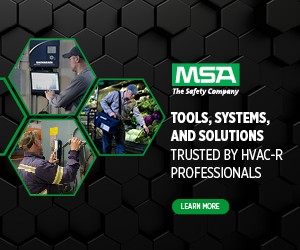Circuit Court Supports Tampa Electric’s Response to a Release
“The finding of the court is important because it should permit our industry to respond to incidents that are controllable without necessarily assuming they are fully actionable emergency response scenarios requiring specialized hazmat teams with specialized equipment, such as self-contained breathing apparati,” said Eric Smith, vice president and technical director for IIAR.
THE CASE
TECO uses ammonia to reduce nitrous oxide emissions which are a byproduct of power generation. Its plant was designed and built so that if an ammonia supply pipe becomes over-pressurized, ammonia is diverted to a sump—an underground water tank that absorbs and neutralizes the ammonia sent to it. Once the sump water becomes saturated with ammonia and is unable to absorb more, the system releases excess ammonia through the sump’s vent pipe and into the outside air to prevent the overpressure from rupturing the supply pipe and causing a massive spill of ammonia.
When the system detected an overpressure in 2017, some excess ammonia was released through the sump vent, as designed, and an ammonia alarm sounded. Specially trained technicians, called rovers, responded and helped put an end to the release. The technicians responding to the release used their training to ascertain the extent of the release, assess the problem, and stop the release, but they were not wearing self-contained breathing apparatuses (SCBAs). OSHA issued a two-item serious citation alleging violations of the Hazardous Waste Operations and Emergency Response (HAZWOPER) standard, 29 C.F.R. § 1910.120.
TECO argued that the incident did not fall within the definition of an emergency response. The Occupational Safety and Health Review Commission (OSHRC), an independent tribunal, agreed and vacated OSHA’s citation. OSHA appealed.
IIAR believed the case’s outcome would be crucial to the food industry and many other industries that use ammonia in their processes. IIAR teamed with the National Manufacturers Association and Edison Electric in filing an amicus brief to inform the court of the ramifications of an unfavorable decision and weigh these against the alternative.
“We wanted the court to understand the importance of a decision and how it could have potentially affected our industry and potentially their industries,” Smith said, adding that the amicus brief was accepted by the court. “We felt like it was influential in the court’s decision.”
Lowell Randel, senior vice president of government and legal affairs for the Global Cold Chain Alliance, said submitting the amicus brief was an easy decision. “The precedent of what the court decides could have long-ranging impacts on how OSHA handles these situations going forward. We wanted to make sure our voice was heard and that the precedent set by the court was in our favor and appropriate to what goes on in the industry,” he said.
What’s more, this was an opportunity for IIAR to get involved in a critical legal issue. “We work closely with agencies, stakeholders, and partners, and this showed IIAR can also be actively engaged when these issues elevate to a legal question and effectively represent the industry and its interests on another platform,” Randel said. “It is an important case because it covered a question that can arise with OSHA in any ammonia release situation.”
THE LATEST COURT ACTION
In rejecting OSHA’s appeal, the court’s decision focused on and was limited to the “uncontrolled release” issue. The court held that OSHA failed to show that the release was “uncontrolled.”
“Thankfully, the court found that the release, in this case, was not uncontrolled and that Tampa Electric designed a response system to manage when and how to deal with releases and to what extent ammonia would be emitted in the event of a pipe over pressurization,” Randel said. “The court basically found because Tampa Electric had those procedures in place, it was not by definition an uncontrolled release. Thus it did not trigger the HAZWOPER standard.
The court wrote, “[W]e are satisfied that Tampa Electric designed a response system to manage when, how, and to what extent ammonia would be emitted in the event of a pipe overpressurization and thereby adequately “controlled” the release.” Because the release wasn’t uncontrolled, the response to it wasn’t an ‘emergency response,’ and the HAZWOPER standard didn’t apply to the rovers’ conduct. “And because the HAZWOPER standard didn’t apply, Tampa Electric didn’t violate it,” according to the decision.
Gary Smith, president and CEO of the Ammonia Safety & Training Institute, said the court’s decision gives the use of industry best practices, such as the International Institute of Ammonia Refrigeration (IIAR) “Critical Task Guidance for Ammonia Refrigeration System Emergency Planning” document, a higher level of credibility for supporting the industrial and public safety response team as they address critical tasks such as incidental system control, emergency system control for a release within a hazard zone, and the ability for first responders with training and personal protective equipment to perform rapid entry rescue.
While the HAZWOPPER regulation has its place and is an important regulation, it shouldn’t be the blanket response anytime there is an ammonia release. “The decision helped solidify that if a facility has a plan in place and they follow their plan, they’re not going to automatically be thrown into the HAZWOPPER standard,” Randel said. The court’s opinion is so narrow and so well grounded on the facts that no motion for reconsideration by OSHA is expected.
Although the court upheld the decision of the commission, it did not directly address other matters, including what factors constitute an emergency response or the extent of OSHA’s authority over performance-based procedures.
“IIAR will be examining the court’s decision and considering what our industry could and should do to affect reasonable responses to leak and release scenarios that can be addressed quickly and safely without the assistance of hazmat teams,” Eric Smith said. “The recommendations provided in the ‘Critical Task Guidance for Ammonia Refrigeration System Emergency Planning’ will be significant for facilities to implement in the wake of this court decision.”















